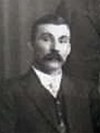Elections in Australia take place periodically to elect the legislature of the Commonwealth of Australia, as well as for each Australian state and territory and for local government councils. Elections in all jurisdictions follow similar principles, although there are minor variations between them. The elections for the Australian Parliament are held under the federal electoral system, which is uniform throughout the country, and the elections for state and territory Parliaments are held under the electoral system of each state and territory. An election day is always a Saturday, but early voting is allowed in the lead-up to it.
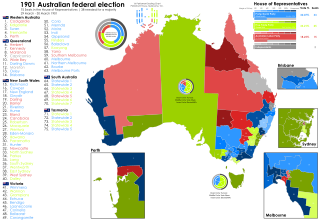
The 1901 Australian federal election for the inaugural Parliament of Australia was held in Australia on Friday 29 March and Saturday 30 March 1901. The elections followed Federation and the establishment of the Commonwealth of Australia on 1 January 1901. All 75 seats in the Australian House of Representatives, six of which were uncontested, as well as all 36 seats in the Australian Senate, were up for election.
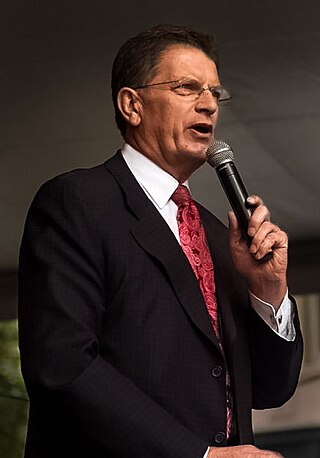
The 2010 Victorian state election, held on Saturday, 27 November 2010, was for the 57th Parliament of Victoria. The election was to elect all 88 members of the Legislative Assembly and all 40 members of the Legislative Council. The incumbent centre-left Labor Party government, led by John Brumby, was defeated by the centre-right Liberal/National Coalition opposition, led by Ted Baillieu. The election gave the Coalition a one-seat majority in both houses of parliament.

Elections were held in the state of Western Australia on 3 October 1911 to elect 50 members to the Western Australian Legislative Assembly. The Labor Party, led by Opposition Leader John Scaddan, defeated the conservative Ministerialist government led by Premier Frank Wilson. In doing so, Scaddan achieved Labor's first absolute majority on the floor of the Assembly and, with 68% of the seats, set a record for Labor's biggest majority in Western Australia. The record would stand for nearly 106 years until Labor won 69% of seats at the 2017 election. The result came as something of a surprise to many commentators and particularly to the Ministerialists, as they went to an election for the first time as a single grouping backed by John Forrest's Western Australian Liberal League, under a new system of compulsory preferential voting and new electoral boundaries both of which had been passed by Parliament earlier in the year despite ardent Labor opposition.
This is a list of members of the Western Australian Legislative Assembly between the 1905 elections and the 1908 elections, together known as the Sixth Parliament.
This is a list of members of the Western Australian Legislative Assembly between the 1904 elections and the 1905 elections, together known as the Fifth Parliament.

Elections were held in the state of Western Australia between 27 April and 26 May 1897 to elect 44 members to the Western Australian Legislative Assembly. The Ministerialist group led by John Forrest won a third term in office as a result of the elections. The poll took place based on boundaries established in the Constitution Act Amendment Act 1896, which increased the number of members from 33 mainly by adding new seats in the Goldfields region, and had been called a year earlier than was necessary. In 18 of the 44 seats, only one candidate nominated and polls were not held.
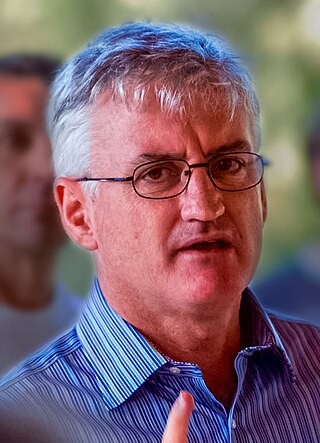
The 2008 Western Australian state election was held on Saturday 6 September 2008 to elect 59 members to the Legislative Assembly and 36 members to the Legislative Council. The incumbent centre-left Labor Party government, in power since the 2001 election and led since 25 January 2006 by Premier Alan Carpenter, was defeated by the centre-right Liberal Party opposition, led by Opposition Leader Colin Barnett since 6 August 2008.
Elections were held in the state of Western Australia on 24 April 1901 to elect 50 members to the Western Australian Legislative Assembly. It was the first election to take place since responsible government without the towering presence of Premier Sir John Forrest, who had left state politics two months earlier to enter the first Federal parliament representing the Division of Swan, and the first state parliamentary election to follow the enactment of women's suffrage in 1899.

The 2013 Western Australian state election was held on Saturday 9 March 2013 to elect 59 members to the Legislative Assembly and 36 members to the Legislative Council.
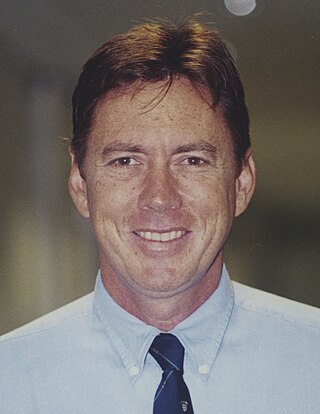
A general election was held in the Northern Territory on Saturday 25 August 2012, which elected all 25 members of the Legislative Assembly in the unicameral Northern Territory Parliament.
This is a list of members of the 11th Legislative Assembly of Queensland from 1893 to 1896, as elected at the 1893 colonial election held between 18 April 1893 and 25 May 1893.
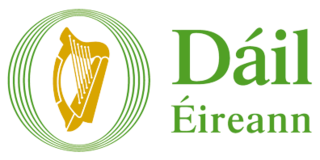
Dáil Éireann is the lower house and principal chamber of the Oireachtas, which also includes the president of Ireland and a senate called Seanad Éireann. It consists of 174 members, each known as a Teachta Dála. TDs represent 43 constituencies and are directly elected for terms not exceeding five years, on the system of proportional representation by means of the single transferable vote (PR-STV). Its powers are similar to those of lower houses under many other bicameral parliamentary systems and it is by far the dominant branch of the Oireachtas. Subject to the limits imposed by the Constitution of Ireland, it has power to pass any law it wishes, and to nominate and remove the Taoiseach. Since 1922, it has met in Leinster House in Dublin.

Elections were held in the Australian state of Queensland on 27 August 1904 to elect the members of the state's Legislative Assembly. The Ministerial Party maintained government with the continued support of the Labour Party.

The 1907 Victorian state election was held in the Australian state of Victoria on Friday, 15 March 1907 to elect 45 of the 65 members of the state's Legislative Assembly. The other 20 seats were uncontested.
Elections were held in the Australian state of Western Australia on 28 June 1904 to elect 50 members to the state's Legislative Assembly.
Elections were held in the Australian state of Western Australia in late 1905 to elect 50 members to the state's Legislative Assembly. The main polling day was 27 October, although four remote electorates went to the polls on 13 November.

The 1902 Victorian state election was held in the Australian state of Victoria on 1 October 1902, to elect 70 of the 95 members of the Victorian Legislative Assembly. The other 25 seats were uncontested.

The 2020 Groom by-election was held on 28 November 2020 to elect the next Member of Parliament for the division of Groom in the House of Representatives. The by-election was triggered following the resignation of incumbent Liberal National MP John McVeigh on 18 September 2020.
A by-election for the Western Australian Legislative Assembly seat of East Perth was held on 20 October 1904. It was triggered by the resignation of former Ministerialist Premier Walter James, who was appointed to take up the role of Agent General for Western Australia. The election was won by Ministerialist candidate John Hardwick, who beat the Labor Party's John Curran.

